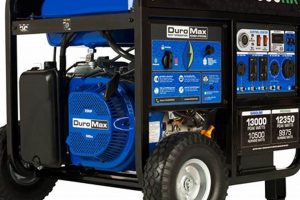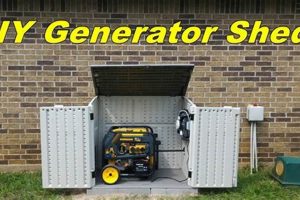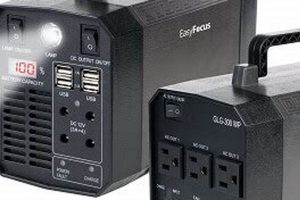Powering a home’s central air conditioning system with a portable generator involves matching the generator’s output capacity to the AC unit’s power requirements. A central AC unit draws significant power, particularly during startup, so a sufficiently sized generator is essential. For example, a 5,000-watt generator might power a smaller AC unit, but a larger home with a higher-capacity system could require 10,000 watts or more.
Maintaining climate control during power outages can be critical for comfort, health, and the preservation of perishable goods. Historically, homes without grid power had limited cooling options. The advent of portable generators provided a practical solution, allowing for temporary operation of essential appliances like air conditioners. This capability is particularly valuable in regions prone to extreme temperatures or extended power disruptions.
Several factors determine the feasibility and safety of this approach, including the generator’s wattage, the air conditioner’s starting and running wattage, and proper connection procedures. Understanding these elements is crucial for safe and effective operation.
Tips for Powering Central Air with a Portable Generator
Operating a central air conditioning system with a portable generator requires careful planning and execution. The following tips offer guidance for safe and effective operation.
Tip 1: Determine Air Conditioner Wattage: Locate the air conditioner’s nameplate to identify its running and starting wattage requirements. The starting wattage, often significantly higher, represents the initial surge of power needed to start the compressor.
Tip 2: Select an Appropriately Sized Generator: Choose a generator with sufficient wattage to handle both the running and, crucially, the starting wattage of the air conditioner. Opting for a generator with higher capacity provides a margin of safety and allows for potential future appliance additions.
Tip 3: Use a Transfer Switch: A transfer switch is essential for safely connecting the generator to the home’s electrical system. It prevents backfeeding, a dangerous condition that can harm utility workers and damage appliances. Direct connection to the air conditioner is strongly discouraged.
Tip 4: Consult a Qualified Electrician: Professional installation of a transfer switch ensures compliance with electrical codes and safe operation. An electrician can assess the home’s electrical system and recommend an appropriately sized transfer switch and generator.
Tip 5: Prioritize Essential Circuits: During a power outage, prioritize essential circuits connected to the generator. Powering only necessary appliances reduces the load on the generator and ensures sufficient power for the air conditioner.
Tip 6: Regular Maintenance: Maintain the generator according to manufacturer instructions, including regular oil changes and inspections. This ensures optimal performance and extends the generator’s lifespan.
Tip 7: Proper Ventilation: Operate the generator outdoors in a well-ventilated area, away from windows and doors, to prevent carbon monoxide poisoning.
Following these precautions ensures safe and effective operation of a central air conditioning system with a portable generator, providing essential cooling during power outages. Neglecting these considerations can lead to equipment damage, safety hazards, and ineffective operation.
Successfully powering an air conditioner with a portable generator requires careful consideration of power requirements, safety procedures, and proper equipment. Implementing these measures allows for effective climate control during power disruptions.
1. Generator Capacity (Wattage)
Generator capacity, measured in watts, is the cornerstone of successfully powering a central air conditioner with a portable generator. It represents the maximum power output the generator can sustain, directly impacting whether or not it can handle the electrical demands of an AC unit. Understanding wattage requirements is essential for avoiding overload, ensuring safe operation, and preventing equipment damage.
- Running Wattage vs. Starting Wattage
Air conditioners require a higher surge of power to start the compressor, known as the starting wattage, which typically exceeds the continuous power needed to maintain operation (running wattage). A generator must accommodate both. For instance, a 3-ton AC unit might have a running wattage of 3,000 watts and a starting wattage of 9,000 watts. Selecting a generator based solely on running wattage will likely result in failure to start.
- Generator Size and AC Unit Size
Larger air conditioning units generally require more powerful generators. A small window AC unit might operate on a 2,000-watt generator, while a whole-house central air system could necessitate a 10,000-watt or larger generator. Accurately assessing the AC unit’s power needs is critical for matching it with a suitably sized generator.
- Overloading and Its Consequences
Attempting to power an air conditioner with an undersized generator can lead to generator overload. This can damage the generator, the AC unit, and connected appliances. Overloading also presents a fire hazard. Always operate a generator within its specified wattage limits.
- Calculating Total Power Requirements
When determining generator capacity, consider the combined wattage of all appliances intended for simultaneous use. If, in addition to the air conditioner, lights or refrigerators are necessary, their wattage must be added to the AC unit’s requirements to calculate the total power demand. This comprehensive assessment ensures the generator can handle the cumulative load.
Accurate wattage assessment and generator selection are paramount for the safe and effective operation of a central air conditioner powered by a portable generator. Failure to adequately address these considerations can result in equipment damage, safety hazards, and ineffective climate control during power outages. Prioritizing proper wattage matching is essential for successful implementation.
2. Air Conditioner Power Requirements
Air conditioner power requirements are fundamental to determining whether a portable generator can successfully operate a central AC unit. These requirements, expressed in watts, dictate the electrical load the AC unit places on the power source. A mismatch between the generator’s capacity and the air conditioner’s needs can lead to operational failure, equipment damage, and safety hazards. The starting wattage, representing the initial surge of power required to engage the compressor, often significantly exceeds the running wattage needed for sustained operation. For example, a 5,000 BTU window air conditioner might have a running wattage of 500 watts and a starting wattage of 1,500 watts. A generator capable of handling only the running wattage would likely fail to start the unit. A central AC unit for a typical home might require a starting wattage exceeding 10,000 watts, significantly impacting generator selection. Understanding both the running and starting wattage requirements is essential for proper generator sizing.
Accurately assessing air conditioner power requirements is crucial for several reasons. First, it ensures the selected generator possesses sufficient capacity to start and run the AC unit reliably. Second, it prevents generator overload, protecting both the generator and the connected appliances from damage. Third, correct wattage matching contributes to safe operation, minimizing risks associated with electrical overloads. For instance, using a 2,000-watt generator to power a central AC unit requiring 8,000 starting watts could result in generator failure, potentially causing damage to the unit and creating a fire hazard. Conversely, understanding that a small window AC unit might only need 500 running watts allows for the selection of a smaller, more fuel-efficient generator. This careful consideration of power requirements promotes efficient and safe operation.
In conclusion, a comprehensive understanding of air conditioner power requirements is indispensable when considering using a portable generator. Properly matching generator capacity to AC unit needs ensures reliable operation, prevents equipment damage, and promotes safety. Failure to consider these requirements can have significant negative consequences. Accurate wattage assessment forms the foundation for successfully powering an air conditioner with a portable generator, enabling effective climate control during power disruptions. Neglecting these critical details undermines the entire endeavor.
3. Transfer Switch Necessity
Safe and effective operation of a central air conditioning system with a portable generator hinges critically on the use of a transfer switch. This device plays a vital role in isolating the home’s electrical system from the utility grid during generator operation, preventing a dangerous phenomenon known as backfeeding. Backfeeding occurs when electricity flows from the generator back into the power lines, posing a significant electrocution risk to utility workers and potentially damaging appliances. A transfer switch provides a safe, code-compliant pathway for generator power, protecting both people and equipment.
- Preventing Backfeeding
The primary function of a transfer switch is to prevent backfeeding. Without it, electricity generated by the portable generator can flow back into the utility grid, energizing downed power lines and creating a life-threatening hazard for utility workers attempting repairs. Backfeeding also poses a risk to individuals in the vicinity of these energized lines, potentially causing severe electrical shock.
- Protecting Appliances
A transfer switch safeguards appliances from voltage fluctuations that can occur during generator operation. By isolating the home’s electrical system from the grid, it prevents surges and inconsistencies in power delivery that might damage sensitive electronic equipment. This protection extends to the air conditioning unit itself, preserving its operational integrity.
- Code Compliance and Safety Standards
Most jurisdictions require the use of a transfer switch when connecting a portable generator to a home’s electrical system. This requirement stems from the inherent safety risks associated with backfeeding and improper generator connection. Adhering to these codes ensures legal compliance and mitigates potential hazards. Ignoring these regulations can lead to fines and jeopardizes safety.
- Types of Transfer Switches and Professional Installation
Transfer switches come in various configurations, including manual and automatic options. Manual switches require physical engagement to switch between utility and generator power, while automatic switches detect power outages and engage the generator automatically. Consulting a qualified electrician is crucial for selecting the appropriate transfer switch and ensuring proper, code-compliant installation. Professional installation guarantees safety and optimal functionality.
The necessity of a transfer switch when powering central air conditioning with a portable generator cannot be overstated. It safeguards utility workers, protects appliances, and ensures compliance with electrical codes. Attempting to operate a central AC unit without a properly installed transfer switch is inherently dangerous and potentially damaging. Prioritizing the installation of a transfer switch is paramount for responsible and safe generator use, contributing significantly to the overall viability and safety of powering central air with a portable generator during power outages.
4. Safety Precautions
Operating a central air conditioner with a portable generator necessitates stringent adherence to safety precautions. Overlooking these critical measures can lead to severe consequences, including carbon monoxide poisoning, fire hazards, electrocution, and equipment damage. Implementing appropriate safety protocols is paramount for protecting individuals and property.
- Carbon Monoxide Poisoning Prevention
Generators produce carbon monoxide, an odorless, colorless, and lethal gas. Operating a generator indoors or in enclosed spaces poses a severe risk of carbon monoxide poisoning. Generators must be placed outdoors, far from windows, doors, and vents, ensuring adequate ventilation. Carbon monoxide detectors should be installed and regularly tested to provide early warning of dangerous accumulations.
- Fire Hazard Mitigation
Generators utilize flammable fuel, presenting a fire hazard if improperly handled. Refueling a hot generator can ignite fuel vapors, leading to explosions or fires. Allow the generator to cool completely before refueling. Store fuel in approved containers away from ignition sources. Keep a fire extinguisher readily available near the generator, ensuring it is rated for gasoline fires.
- Electrocution Prevention
Improper generator connection can create electrocution risks. Never connect a generator directly to household wiring without a properly installed transfer switch. Direct connection can backfeed electricity into the utility grid, endangering utility workers. Ensure all connections are dry and free from damage. Ground the generator according to manufacturer instructions to mitigate electrical shock hazards.
- Generator Overload Protection
Operating a generator beyond its wattage capacity can lead to overheating and potential damage. Calculate the total wattage of all appliances intended for simultaneous use with the generator. Avoid exceeding the generator’s rated capacity. Overloading can damage both the generator and connected appliances, including the air conditioner, and may create a fire hazard.
Safe operation of a central air conditioner with a portable generator requires diligent attention to these safety precautions. Neglecting these measures can have dire consequences, impacting personal safety and property. Prioritizing safety protocols is essential for responsible generator use and ensures effective, risk-mitigated climate control during power outages.
5. Professional Consultation
Professional consultation plays a crucial role in safely and effectively powering central air conditioning with a portable generator. Given the inherent complexities and potential hazards associated with connecting a generator to a home’s electrical system, seeking expert advice is paramount. A qualified electrician possesses the technical expertise to assess the specific requirements of the air conditioning unit, determine the appropriate generator size, and ensure proper installation of the necessary components, including the crucial transfer switch. This professional guidance mitigates risks, optimizes performance, and ensures adherence to safety standards and electrical codes. Attempting such a project without professional input can lead to costly mistakes, equipment damage, and safety hazards.
For instance, an improperly sized generator can fail to start the air conditioner or cause damage due to overloading. A poorly installed transfer switch can create a backfeeding scenario, endangering utility workers and potentially damaging appliances. A licensed electrician understands these complexities and can accurately calculate load requirements, recommend appropriate equipment, and ensure safe installation and operation. Consider a scenario where a homeowner attempts to connect a generator directly to the air conditioner without a transfer switch. This action could energize downed power lines during an outage, posing a life-threatening risk to utility workers. Professional consultation prevents such hazardous situations, ensuring the well-being of both individuals and the electrical system.
In conclusion, professional consultation is an indispensable component when considering running central air conditioning with a portable generator. Expert guidance ensures the safe and effective implementation of this strategy, mitigating potential hazards and maximizing performance. The cost of professional consultation is a small price to pay compared to the potential costs of equipment damage, fines for code violations, or, most importantly, the risk to human safety. Prioritizing professional involvement significantly enhances the viability and security of this approach, providing peace of mind and reliable climate control during power disruptions.
Frequently Asked Questions
This section addresses common inquiries regarding the operation of central air conditioning units with portable generators.
Question 1: What size generator is needed to run a central AC unit?
Generator size depends on the air conditioner’s power requirements, specifically its starting and running wattage. Consulting the AC unit’s documentation or a qualified electrician is crucial for accurate sizing. Oversizing the generator slightly provides a safety margin and accommodates potential future needs.
Question 2: Is it safe to connect a generator directly to a central AC unit?
Direct connection is strongly discouraged. A transfer switch is essential to prevent backfeeding, a dangerous condition that can harm utility workers and damage equipment. Professional installation of a transfer switch is recommended.
Question 3: What are the risks of running a central AC unit on a generator?
Risks include carbon monoxide poisoning if the generator is improperly ventilated, fire hazards from flammable fuel, electrocution from improper connections, and equipment damage from overloading. Adhering to safety precautions mitigates these risks.
Question 4: Can a portable generator power other appliances while running a central AC unit?
Potentially, but total wattage draw must be considered. The combined wattage of all operating appliances must not exceed the generator’s capacity. Prioritizing essential circuits is recommended during power outages.
Question 5: How long can a portable generator run a central AC unit?
Runtime depends on the generator’s fuel capacity, fuel efficiency, and the load placed upon it. Larger generators with larger fuel tanks generally offer longer runtimes. Consult the generator’s documentation for specific runtime estimates.
Question 6: What maintenance is required for a generator used to power a central AC unit?
Regular maintenance, as outlined in the generator’s manual, is crucial. This includes oil changes, air filter cleaning, and spark plug replacement. Proper maintenance ensures optimal performance and extends the generator’s lifespan.
Careful consideration of these frequently asked questions provides a comprehensive understanding of the key aspects of operating a central air conditioner with a portable generator. Prioritizing safety and proper operation ensures effective and reliable climate control during power outages.
Further sections will delve deeper into specific aspects of generator operation and safety protocols.
Conclusion
The feasibility of powering a central air conditioning system with a portable generator depends on careful consideration of several factors. Matching generator capacity to the air conditioner’s power requirements is essential. Starting and running wattage demands must be accurately assessed to prevent generator overload and ensure reliable operation. Safe implementation requires a properly installed transfer switch to prevent backfeeding into the utility grid, protecting both utility personnel and equipment. Adherence to safety protocols, including proper ventilation and fuel handling, is crucial for mitigating risks associated with carbon monoxide poisoning and fire hazards. Professional consultation is invaluable for system design, equipment selection, and safe installation.
Effective climate control during power outages is a significant concern for homeowners. Portable generators offer a potential solution, but successful implementation requires informed decision-making and meticulous attention to safety. Understanding the technical aspects of generator operation, air conditioner power requirements, and safe connection procedures is paramount for achieving reliable and safe performance. Investing in appropriate equipment and seeking professional guidance ensures a resilient and secure power solution for maintaining comfort and safety during grid disruptions. Ultimately, preparedness and responsible operation are key to successfully leveraging portable generators for essential climate control.






